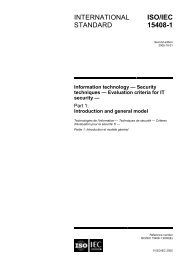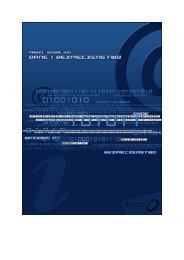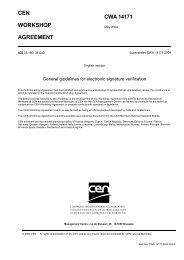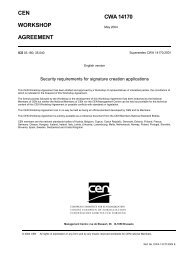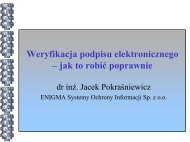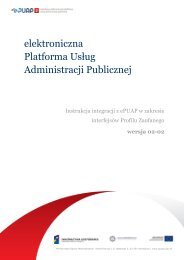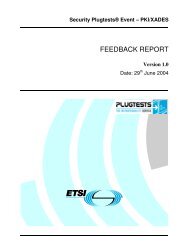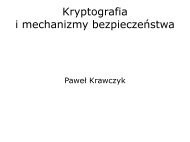When electronic signature becomes a information services ... - IPSec
When electronic signature becomes a information services ... - IPSec
When electronic signature becomes a information services ... - IPSec
Create successful ePaper yourself
Turn your PDF publications into a flip-book with our unique Google optimized e-Paper software.
is necessary to view the document, unblock the smart card, view the legal notices (which are<br />
substantial) and sign – it is not possible to make it a fast and automated process. 45<br />
The e-invoicing security model centres around the authenticity of the company of origin, and<br />
the integrity 46 of the content – and that is all that is required (as explicitly stated in Directive<br />
2001/115/EC 47 ). The QES provides for a reasonably strong link to an individual person and<br />
technical non-repudiation. The latter aspect increases the cost and makes it unsuitable for e-<br />
invoicing. This means the security requirements of e-invoicing and the features provided by a<br />
QES are largely contrary to what is required.<br />
As mentioned above, Directive 2001/115/EC requires ‘authenticity and integrity’ of an e-<br />
invoice, but it does not require a QES (it merely allows the use of a qualified <strong>electronic</strong><br />
<strong>signature</strong> along with other methods). However, Polish legislation has chosen the QES-only<br />
approach, also allowing EDI. Supporters of QES-only e-invoices raised three main types of<br />
arguments: the highest level security is required for customers to trust e-invoices; any other<br />
integrity protection other than QES will confuse customers, and e-invoices should promote<br />
QES (a circular argument). 48<br />
Polish statistics from 2007 49 indicated that only 5 per cent of companies were exposed to e-<br />
invoicing, and out of that, most were supermarkets using EDI, and not the QES. The QES<br />
based e-invoicing exchange between small and medium companies is still practically non-<br />
45<br />
Most QES applications require at least six steps to place a digital <strong>signature</strong>; longer for communications with a smart card. A<br />
number of invoices may be signed with one operation, but this would only work for companies who issue them once a month for instance. In<br />
addition, some experts raised a need to use time stamping, because the certificate is only valid for two years, and the minimum life time of an<br />
invoice in Poland is five years. Each time stamp costs money, and takes a few seconds to complete, especially if a third party service is used.<br />
46<br />
The simplest means of making an e-invoice authentic and integral is making it available for download from an SSL web site, either<br />
as printable text (as Google Europe does) or a PDF file (as cable operator UPC does). In the long-term (at least in e-invoicing terms),<br />
authentication and integrity can be provided by digitally signing the PDF with a commercial certificate, that can be generated automatically –<br />
many banks sending credit card statements already use this technique (although note the comments in Stefanie Fischer-Dieskau and Daniel<br />
Wilke, ‘Electronically signed documents: legal requirements and measures for their long-term conservation’, Digital Evidence and Electronic<br />
Signature Law Review, 3 (2006) 40 – 44).<br />
47<br />
Directive 2001/115/EC requires protection for the authenticity and integrity of the data, and presents a relatively open catalogue of<br />
technical means to achieve this, including advanced <strong>signature</strong>, QES and EDI.<br />
48<br />
Zbigniew Domaszewicz, Rafał Zasuń, Leszek Baj ‘Konflikt o elektroniczne faktury’, 17 June 2005, Gazeta Wyborcza; Zbigniew<br />
Domaszewicz, Rafał Zasuń ‘E-faktury tylko na papierze’, 29 June 2005, Gazeta Wyborcza; Zbigniew Domaszewicz, ‘Minister nauki podpisał<br />
rozporządzenie o e-fakturach’, 14 July 2005, Gazeta Wyborcza.<br />
49<br />
Survey ‘Wykorzystanie technologii informacyjno-telekomunikacyjnych w przedsiębiorstwach’, (Glowny Urzad Statystyczny,<br />
2007) (‘Use of ICT-in companies’, Central Statistical Office), available at<br />
http://www.stat.gov.pl/gus/5840_wykorzystanie_ict_PLK_HTML.htm?action=show_archive.



